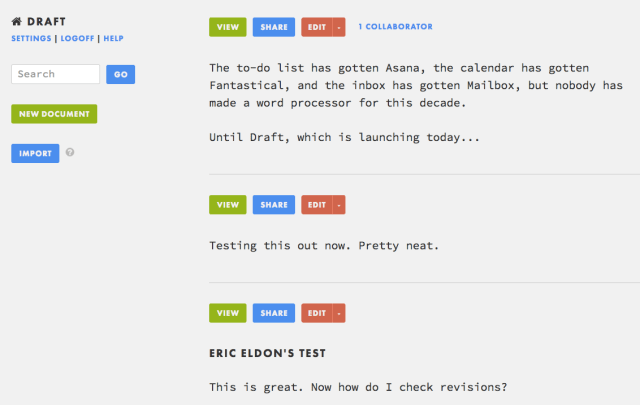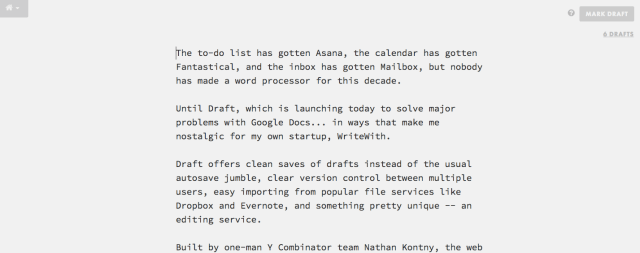The to-do list has gotten Asana, the calendar has gotten Fantastical, and the inbox has gotten Mailbox, but nobody has made a word processor for this decade.
Until Draft, which is launching today to solve major problems with Google Docs … in ways that make me nostalgic for my own startup, WriteWith.
Draft offers clean saves of drafts instead of the usual autosave jumble, clear version control between multiple users, easy importing from popular file services like Dropbox and Evernote, and something pretty unique — an editing service.
Built by one-man Y Combinator team Nathan Kontny (previously the cofounder of Inkling and Cityposh), the web app puts solo writing first. Its interface makes a point of looking nice, with the words you write appearing in large, plain-text font on a light-gray background.
There’s the usual autosave feature that any serious online word processor has, but it also provides a manual “mark draft” button at the top-right corner, because serious writing happens in stages.
Hit the button at any good midpoint and you’ll create a series of drafts that you can easily compare against each other. Let’s say I saved four drafts when writing this story. I can click on “4 drafts” at the top right and see panes for the current draft, as well as each previous one. If you scroll to the left, you can look through each one to see your major revisions as you progressed.
And if you share the link with other users, they can come in and edit. As with your own saved drafts, you can click into the Drafts view to see red background and line-outs on edited text and green on any additions. You can choose to accept newer versions or revert to previous ones. Handily, you can edit your current draft when making side-by-side comparisons with previous ones.
Pause and consider what Draft is trying to be — or not. It’s not bothering with all the formatting and layout options in Microsoft Word, and it’s not trying to play the middle ground like Google Docs. It’s just trying to be the best way you actually write before you publish somewhere else.
To that end, it already lets you import docs from Dropbox, Evernote, Box and Google Drive itself. Once connected, these docs will automatically sync back to their home services.

Overall, Draft will remind pro bloggers of Svbtle, the blog-network startup that offers a slick and minimal content management system, along with editing services. But Draft skips out on publishing tools and blog network attributes in favor of more writing features. It’s focused solely on the creation process and intended for use by a wider variety of writers.
My own startup, WriteWith, was actually building something kind of similar to it, but more designed around newsrooms, and back in 2005-2007 when the market was much less developed. We also offered full-featured version control, and some other stuff like live chat between users in the same document, and a way to set the status to match a newsroom process (posts could be set as “drafts,” “needs editing,” “ready to publish,” etc.). We provided a way to export to publishing software like WordPress and InDesign.
With my experiences in mind, I asked Kontny about exporting to publish features, and he said he’s looking at it. You can easily imagine a way to export your final Draft to WordPress to finish your formatting and multimedia selections, then publish.
But he’s right to ignore it for now because, as I can say from first-hand experience, there are a ton of products out there that writers will want a word processor to integrate with, and each one has its own time-consuming quirks to work through.
But towards the goal of clean exporting, Kontny has made a smart early move and used John Gruber’s Markdown as an export option along with straight HTML. Markdown is a tool for converting text to HTML that provides an especially readable text syntax along with zero script garbage like what you’ll often find in Word and Docs.

A revenue line is also visible for Draft in these early stages of its existence: the editing service. It’s designed for serious individual bloggers or any organization without copy editors. Kontny is sourcing qualified editors to handle copy and as much content-oriented editing as the user wants. Fees vary, and users are offered a satisfaction guarantee. Editor revisions appear as distinct panes that the author can accept, same as any other draft.
Kontny says that a lot of his beta users have been into the service, but I don’t need it because TechCrunch has two great copy editors, and because I’m (over)confident about my own skills when I’m writing on my own.
I’m more interested in where Draft can go if it can establish itself as a main service for writing and editing.
WriteWith failed for many reasons, but a main one was that too many organizations were stubbornly stuck on Word. Six years later, Docs has gone mainstream, and the sophisticated online worker is eager for new, more specialized apps that solve their productivity issues. Fantastical and its easy-add calendar entry interface is a good example.
If Draft can establish itself as the main place where writing happens, you could see it offering an API that lets larger news organizations pull in finished documents to their own workflow and publishing tools. I’m personally going to have TechCrunch look into this.

